Dayton DCX-A Alti-compass watch User Manual Climber DC X E
Dayton Industrial Co., Ltd. Alti-compass watch Climber DC X E
Dayton >
Contents
- 1. User Manual 1
- 2. User Manual 2
User Manual 1
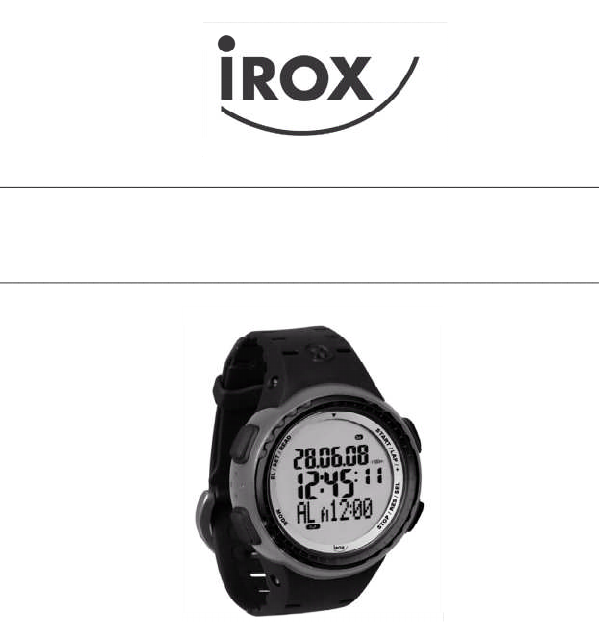
iClimber
-
DCX
Instruction Manual
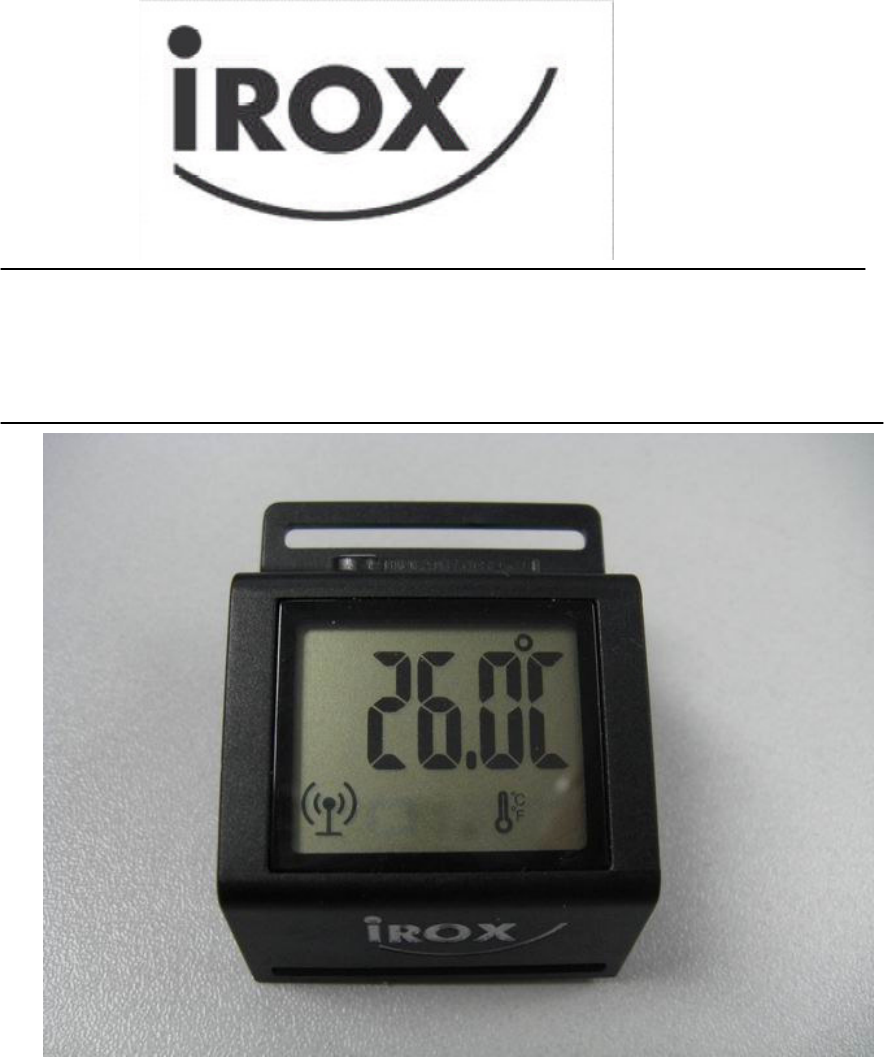
THERMO PEER
Instruction Manual

2
Index
1. INTRODUCTION................................................................................................... 4
2. PUTTING INTO OPERATION ............................................................................... 6
3. OPERATION ELEMENTS ..................................................................................... 7
3.1 LCD DISPLAY AND BUTTONS...................................................................... 7
3.2 OPERATION LOGIC OF BUTTONS .............................................................. 8
3.3 LOCKING THE BUTTONS (“KEY-LOCK”)...................................................... 9
3.4 MEANING OF THE LCD ICONS .................................................................. 10
3.5 BEZEL ........................................................................................................ 11
3.6 BATTERY COMPARTMENT........................................................................ 12
4. FUNCTIONS AND OPERATION ......................................................................... 12
4. FUNCTIONS AND OPERATION ......................................................................... 13
4.1 TIME (TIME AND ALARM)........................................................................... 15
4.1.1 Local time (T1)..................................................................................... 16
4.1.2 Time zone (T2)..................................................................................... 17
4.1.3 Alarm (AL)............................................................................................ 17
4.2 TIMER.......................................................................................................... 19
4.3 SPORT (STOPWATCH, VERTIC-LOG, PEER)....................................... 22
4.3.1 STOPWATCH with LAP and VERTIC-LOG function............................. 24
4.3.2 PEER Settings ..................................................................................... 34
4.4 DATA LOG (RETRIEVING STORED DATA) ................................................ 37
4.5 ALTIMETER (ALTIMETER, THERMOMETER) ............................................ 43
4.6 BAROMETER (AIR PRESSURE, WEATHER, MEASURING UNITS)........... 48
4.6 BAROMETER (AIR PRESSURE, WEATHER, MEASURING UNITS)........... 49
4.7 COMPASS................................................................................................... 54
5. BATTERY REPLACEMENT ............................................................................... 58
6. MAINTENANCE .................................................................................................. 58
7. SUPPORT........................................................................................................... 59
8. TECHNICAL INFORMATION .............................................................................. 60
9. VERTIC-LOG – HOW TO USE............................................................................ 61

3
10. THERMO PEER................................................................................................ 63
10.1 PUTTING THE THERMO PEER INTO OPERATION ................................. 64
10.2 OPERATING ELEMENTS THERMO PEER ............................................... 65
10.2.1 LCD DISPLAY AND KEYS................................................................. 65
10.2.2 OPERATING LOGICS OF THE KEYS ............................................... 66
10.2.3 MEANING OF THE LCD ICONS ........................................................ 67
10.2.4 SETTING OF THE TIME.................................................................... 68
10.2.5 SETTING OF THE TEMPERATURE UNIT........................................ 69
10.2.6 ACTIVATE SYNC MODE.................................................................. 69
10.2.7 ACTIVATE UPLOAD MODE ............................................................. 70
10.2.8 TECHNICAL INFORMATION............................................................. 71
FCC ID: 04GDCX-A ................................................................................................ 72
Brief instruction DATA LOG seperate sheet
Version 1.06022009
• Index
Remark:
The Model Name of "iClimber-DCx and "Thermo Peer" is equivalent to
"Alti-Compass DCX" and "T-Pod" respectively.

4
1. INTRODUCTION
Thank you for choosing the iClimber-DCX by IROX. You are now the owner of a high
quality watch which is the result of Italian design, Swiss engineering, Canadian and
Swiss technology, and is manufactured in the greater Hong Kong area.
The iClimber-DCX offers true novelties in the watch market. Among other things the
VERTIC-LOG® function, which was developed in cooperation with Swiss mountain
guides. Besides the operating steps described in chapter 4 you will also find an
explanation of how to use this function in chapter 9 and why mountain guides
requested this function.
The DCX offers additional functions that can be used with periphery devices (‘peers’)
that have a 2.4GHz signal:
- Thermo Peer with THERMO-LOG®
- Heart Peer (chest belt to measure pulse)
- Foot Peer (running sensor for the shoe)
- PC Peer (USB stick with PC software for data analysis)
All these peers are options and can be purchased separately.
The Thermo Peer with the THERMO-LOG function is an IROX innovation. This
function makes the DCX the first wristwatch that can measure the real ambient
temperature and also display it on the watch.
Peer functions are described in these instructions too. If you do not need to use the
respective peer, you can simply skip the corresponding sections. A peer can be put
into operation without restrictions at a later date.

5
Please read the instructions carefully. You will find useful and interesting information
beyond the operation explanations.
About IROX
IROX, as a brand, was founded in the year 2002 in Switzerland. IROX has
established itself as specialist for measuring devices for weather, environment, and
sports and is internationally present. Besides closely collaborating with the best
manufacturers in the electronics branch worldwide, IROX has also developed, and
made market ready, real innovations some of which have totally revolutionised the
market. The weather stations with the Meteotime System are only one example.
The i-Climber DCX with the Vertic-Log and the THERMO-LOG is also an absolute
global innovation.

6
2. PUTTING INTO OPERATION
1. The iClimber is delivered with inserted battery and the watch in a battery
conserving sleep-mode. In this state the display is switched off, “blank”.
2. The watch is activated by pressing any key for at least 3-5 seconds.
3. The watch can now be operated as described in chapter 4.
!Important information
The iClimber is a high quality measuring device with several functions that
you can influence and also some that can not be influenced because they
run in the background (e.g. pressure measurement). Please be aware that
active use of each additional function requires energy and therewith battery.
Often activating the backlight, using the Key-Tone, the compass for bearings
or the peers also draws power from the battery and this has a direct influence
on the battery life.
If you are going on an expedition during which you will be intensely using the
watch and exposing yourself and your equipment to very cold temperatures
we strongly recommend taking along replacement batteries (Type CR2032).
The watch battery, if the watch is simply used as a wristwatch, has a lifetime
of up to one year. The repeated use of several functions can reduce the
battery lifetime by a few months!
• Putting into operation
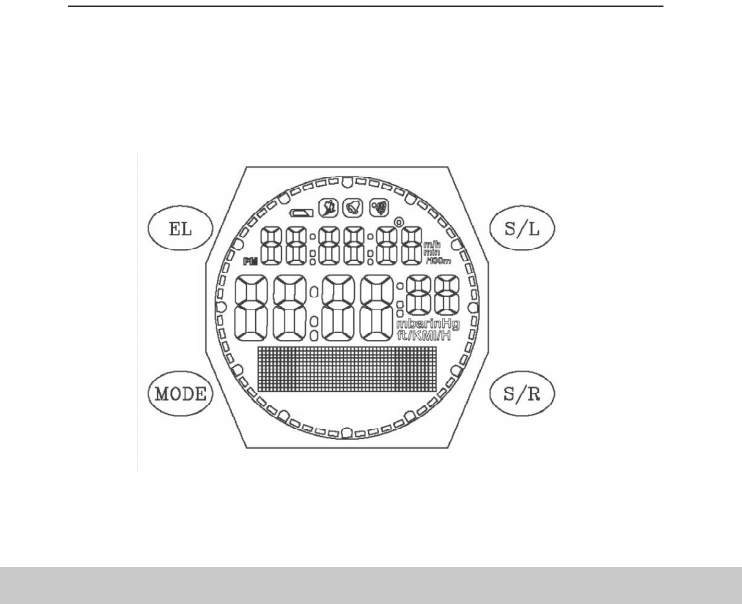
7
3. OPERATION ELEMENTS
3.1 LCD DISPLAY AND BUTTONS
All functions are shown in 5 lines on a liquid crystal display (LCD) and can be
operated with the 4 buttons on the sides.
Complete segment with the four button labels
If displays with data are used in this manual, the data herein will vary from the data
Operation elements
•
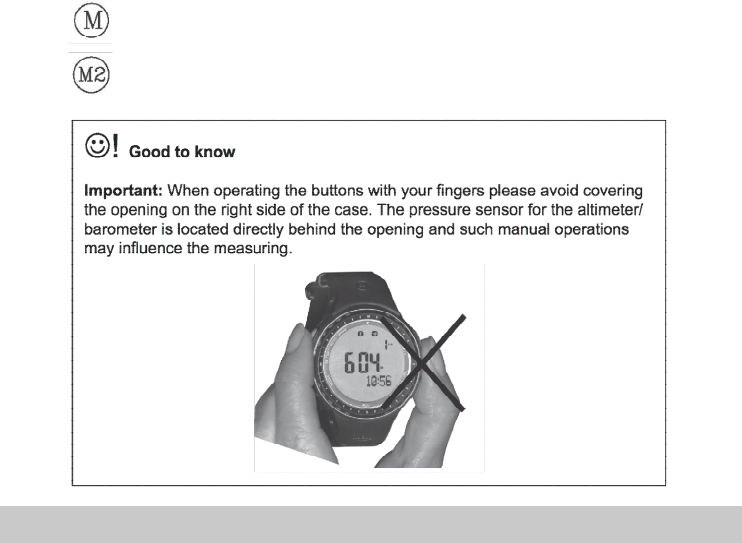
8
on your watch. These printed displays are only for better understanding.
3.2 OPERATION LOGIC OF BUTTONS
The button functions are described in detail in chapter 4. Where button symbols are
used, please remember the following logic:
Press button
Press and hold button for 2 seconds
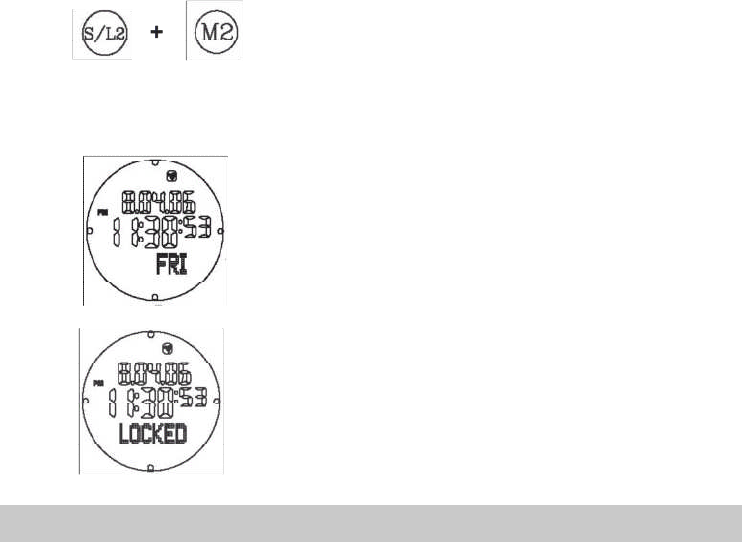
9
3.3 LOCKING THE BUTTONS (“KEY-LOCK”)
You can deactivate the buttons to avoid undesired operation of the buttons:
Activate “Key-Lock”:
Press the M and S/L buttons simultaneously for
at least 2 seconds.
Display for activated “Key-Lock”:
If the buttons are deactivated 4 dots will appear
on the border of the display.
If you press any button in this state, the
information “LOCKED” will appear at the bottom
of the display.
• Operation elements
Operation elements
•
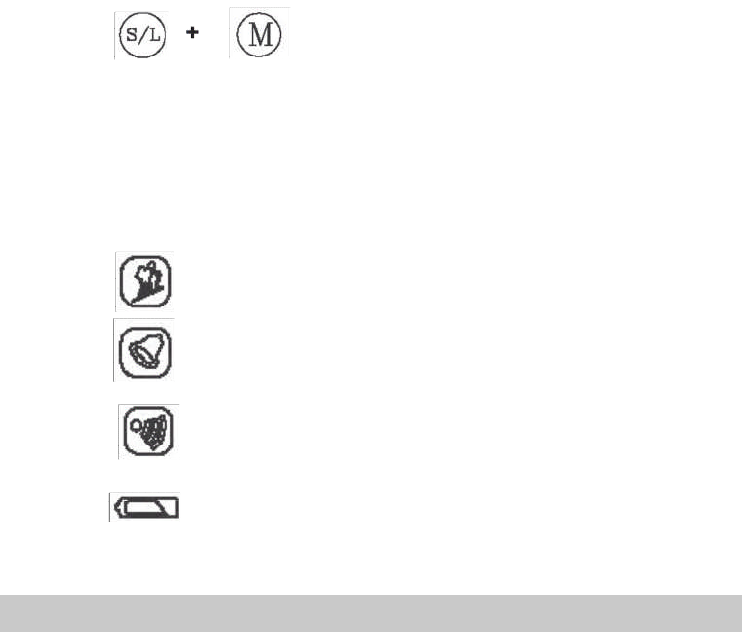
10
Deactivate “Key-Lock”:
Press the M and S/L buttons simultaneously. The
four dots will disappear and the buttons can be
operated again.
3.4 MEANING OF THE LCD ICONS
VERTIC-LOG is active
Alarm is active
Key tone is active
Battery weak (see chapter 2, 3.6 and 5)

11
FOOT-PEER present and active
HEART-PEER present and active
THERMO-PEER present and active
3.5 BEZEL
The bezel serves for position finding with the compass. Operating was arranged in
such a manner that the ring can be turned, but does not move easily when only
slightly brushed.
• Operation elements

12
3.6 BATTERY COMPARTMENT
1x 3V battery type CR2032
You can replace the battery yourself.
Proceed as follows:
– Place the watch face down, on a soft cloth, on a table
– Take a fitting coin (e.g. a 2 Euro or SFR 2 coin) and open the screw cap on the
back of the watch by turning counter clockwise
– Use tweezers to remove the batteries
– Reversing the procedure insert a new battery into the watch (please pay attention
to the correct polarity)
– Make sure that the gasket is still in place. If possible put some silicone grease on
the sealing ring.
– Screw the lid clockwise onto the watch again. Make sure that at least one
complete turn, clockwise, can be conducted without resistance. If this is not
possible the lid is not lying correctly in the thread and too much force would
destroy the thread.
Illustrated instructions can be found at www.irox.com.
Operation elements
•

13
4. FUNCTIONS AND OPERATION
The iClimber has 7 function windows. They are:
TIME Your time (T+), another time zone (T2) and
the alarm time (AL)
TIMER Timer 1 und Timer 2
SPORT Stopwatch, VERTIC-LOG, peer (search, settings,
data dispaly
DATA LOG Retrieval of stored stopwatch data (tour data,
lap times, VERTIC-LOG evaluation, peer data
analysis, PC link)
ALTIMETER Altimeter, current temperature (of the watch and
the Thermo Peer)
BARO Air pressure data, weather forecast and setting
of the measuring units, THERMO-LOG
COMPASS Compass and its calibration
Move from function to function with the
MODE button.
Two additional functions of the watch have a “superior” function available in all
modes: the backlight and the key tone.
• Fun
ctions and operation
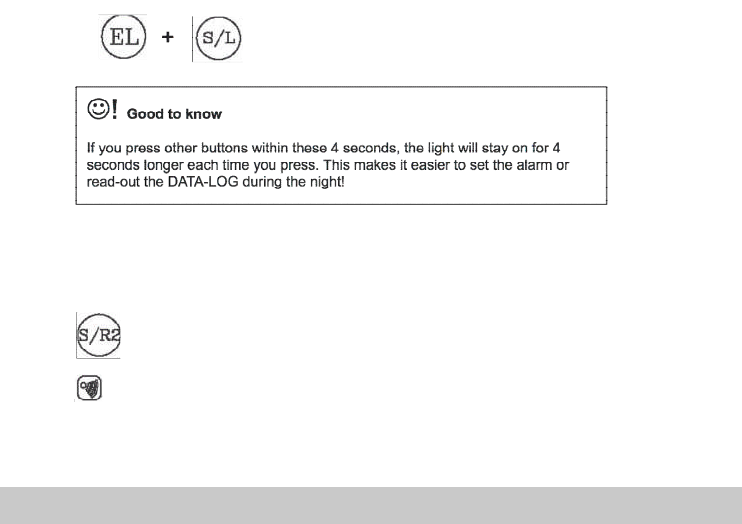
14
a) Backlight
In addition there is the option of switching on a backlight of the display.
To do this, press the EL and S/L buttons
simultaneously. The LCD lighting will be
activated for 4 seconds.
b) Key tone:
You can switch a button sound (“Key tone”) on or off.
move to the time display (with the day displayed
under the time!) and press S/R2
will appear in the upper part of the display and the key tone is active.
To switch off, proceed accordingly in reverse sequence.
Fu
nctions and operation •
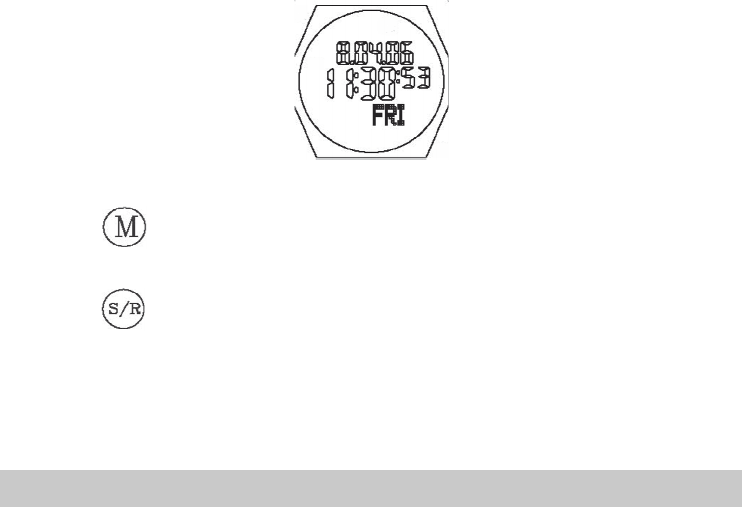
15
4.1 TIME (TIME AND ALARM)
In the time window you can see the time, the date, and the weekday. A second time
zone can also be displayed, and an alarm with a 1-minute alarm sound can be
activated.
Press until TIME appears in the display
You can, at any time, use the same button to
move to the next function, unless you are
conducting a setting.
Select the display in the following
sequence:
– your local time (T1)
– other time zone (T2)
– alarm (AL)
Different entries can be made according to the display.
• Functions and operation

16
4.1.1 Local time (T1)
Press until the day (3 letters, below the minutes) appears on the display.
To switch the key tone on/off
This brings you to the time set mode.
The element to be set will start to blink and a text will appear, in English,
informing you of what needs to be set.
If during setting for longer than one minute no button is pressed,
the watch will automatically leave the set mode. The settings made up
to this point will be stored.
The commands for setting the time are as follows:
With these buttons you change the setting value
Skip to the next setting value (until you leave the set mode)
Leave the set mode. The settings made up to this point will be stored.
Functions and operation •

17
4.1.2 Time zone (T2)
In the time set mode, following the instructions in 4.2.1, you can also set a “T2 Off-
Set”. For this the “OFF Set” setting for time zone T2 is either added or subtracted
from the local time (T1). The Off Set setting can be set from –23 to +23 hours.
Press until “T2” appears in small on the display.
This moves the T2 as main time into the big display.
On the bottom (small T1) your “home time” is displayed.
4.1.3 Alarm (AL)
The watch offers a daily alarm function which, when activated, will sound for one
minute at the time for which it is set.
The valid time for the alarm is the time that appears as the main time (large) on the
display. This can be T1 or T2!
Press until “AL” appears, with the alarm time small.
Activate / Deactivate the alarm. If the alarm is active the bell
symbol will appear at the top of the display:
• Functions and operation

18
This brings you to the set mode for the alarm time.
The element to be set will start to blink and a text will appear, in English,
informing you of what needs to be set.
If during setting for longer than one minute no button is pressed, the
watch will automatically leave the set mode. The settings made up
to this point will be stored.
Attention: The alarm must be activated separately!
The commands for setting the alarm time are as follows:
With these buttons you change the setting value
Skip to the next setting value (until you leave the set mode)
Leave the set mode. The settings made up to here will be stored.
The alarm will sound for 1 minute and, unless the alarm function is
deactivated, will sound again the next day.
The sounding 1 minute alarm tone can be interrupted with this button.
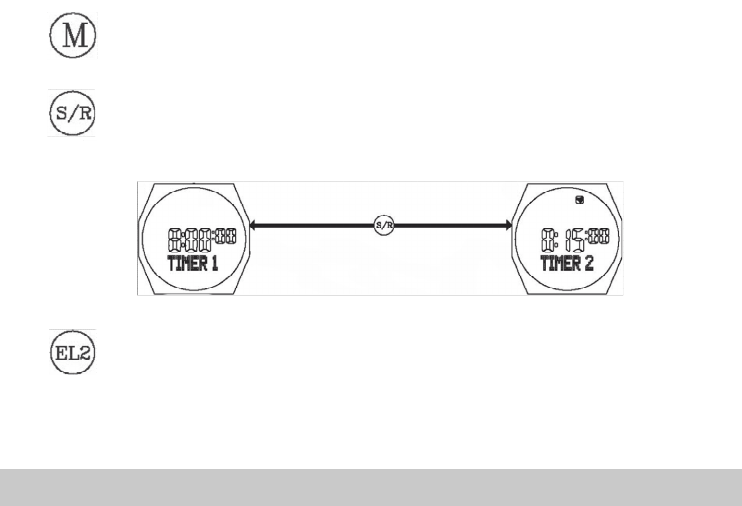
19
4.2 TIMER
In the timer function you can set
a time target and have this time
counted down in seconds to
zero.
There are always two timers
available (TIMER 1 and TIMER 2) which can be set independently of each other.
Press until TIMER appears in the display.
If you are not in a setting mode you can use the same button to,
at any time, move to the next function.
Selecting the timer (TIMER 1
–
TIMER 2)
This brings you to the set mode for the timer.
The element to be set will start to blink and a text will appear, in English,
informing you of what needs to be set.
If during setting for longer than one minute no button is pressed, the
watch will automatically leave the set mode. The settings made up
to this point will be stored.
• Functions and operation
Functions and operation •

20
The timers can not be active together at the same time.
Some special functions can be carried out with the two timers:
INT.LEAVE (Interleave): After the countdown of timer 1, timer 2 starts
automatically.
REPEAT (Repeat): As soon as the active timer has counted down
(in Interleave after the countdown of timer 2),
the counter begins again with the countdown.
CT BEEP (Countdown tone): During the countdown, at certain times,
acoustic signals will sound: A 1 second beep for
each of the last 5, 4, 3,2 and 1 minutes
A 1 second beep for each of the last 50, 40, 30,
20 and 10. During the last 5 seconds a fast
beep-beep will sound. This function can be
used as a Regatta Timer, for example.
At the end of the countdown, when the timer reaches 0:00:00, there will be a signal
(length: 20 seconds)
Time setting of the timer: from 0:01 to 9:59 hours in minute steps.
The commands for setting the time of the timer are as follows:
With these buttons you change the setting value
Skip to the next setting value (until you leave the set mode)
Functions and operation •

21
As soon as the settings have been made, following commands are possible:
Start the timer
Stop the timer
Reset the timer to the initial value (when the timer is stopped)
Interrupt the sounding 20 second tone
• Functions and operation
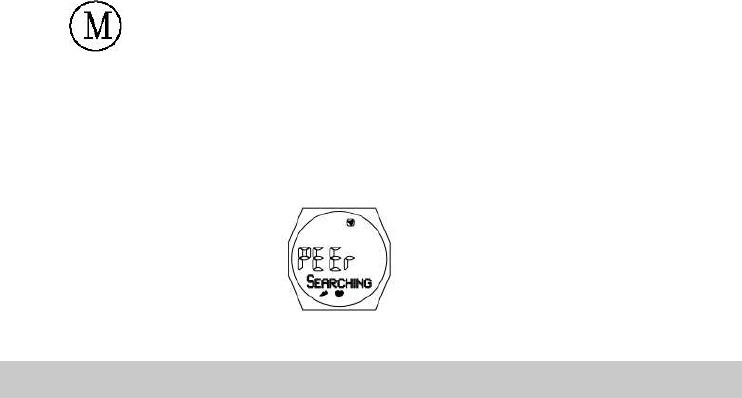
22
4.3 SPORT (STOPWATCH, VERTIC-LOG, PEER)
In the SPORT function the stopwatch is available with up to 99 laps/interims (LAP).
This data can be stored in a LOG at the end of the timing.
The description on how to read-out the measuring blocks (LOG) can be found in
chapter 4.4
The resolution is 1/100 seconds for lap times of up to 59 minutes. Thereafter and for
the accumulated time the resolution is 1 second.
Additional functions such as Vertic-Log and the peers are administered in the SPORT
function in addition to the stopwatch.
Press until SPORT appears on the display.
You can, at any time, use the same button to move to the next
function, unless you are conducting a setting.
The watch first looks for around 15 seconds for the known PEERS, i.e. those that
have already been logged in once (PAIRED – see Chapter 4.3.2.1). The peer icons
flash below on the display (icons, see in Chapter 3.5)

23
Please note: During the display ‘PEER SEARCHING’ you can start the stopwatch
immediately with S/L (Chapter 4.3.1). The function PEER SEARCHING continues to
run in the background (however, the flashing icons are no longer displayed, only as
soon as a PEER has been found does the corresponding icon appear).
It is also possible if no stopwatch is active to enter the setting mode immediately with
the key EL2 (Chapter 4.3.2).
If a peer is recognised as available, the peer icon remains active in the display and
after the 15 seconds the text FOUND briefly appears (1 sec). If no known peer is
found, FOUND is not displayed.
The stopwatch display will then appear. In the assumption that the stopwatch is not
running and is ready at zero, the following display appears:
or
In both cases, the stopwatch function can be used as described below. The following
needs to be taken into account.
- The pulse is only displayed when a pulse belt (HEART PEER) is active.
- The display MEM FULL means that the memory of the data for transfer to the PC is
at least 95% full and further recordings will soon no longer be possible.

24
4.3.1 STOPWATCH with LAP and VERTIC-LOG function
accumulated time of all LAPs in this measuring block
running lap (LAP)
Display of the pulse (only when the HEART PEER is
available and is on the display with the heart icon)
In addition, in the SPORT function, the VERTIC-LOG function is also
activated/deactivated and then started via the stopwatch. If the VERTIC-LOG is
switched on when climbing in the mountains, every 100 m net altitude ascent the
climbing data is stored in the lap memory. The LAP function via the S/L buttons is
switched off.
The operation logic with or without VERTIC-LOG has only slight differences and is
described separately in the following.
The stopwatch also serves to record the times in the respective zone while the
training zones of the pulse belt and/or the running sensor are being used.
Functions and operation •

25
►STOPWATCH with LAP function
Start and restart (“Restart”) the stopwatch
Stops the running stopwatch
●When the stopwatch is running:
Counts laps/interims. The stopwatch continues running.
The LAP time with LAP No. remains on the display for five seconds.
Then the running time of the new lap appears.
Attention: For 5 seconds no other lap time can be measured, that means the
buttons S/L and S/R are inactive during these 5 seconds.
• Functions and operation
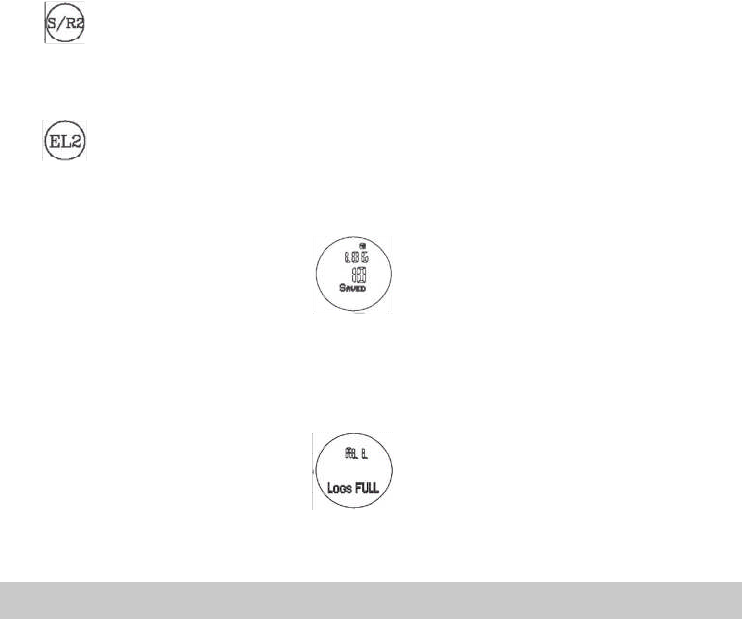
26
●When the stopwatch is stopped
Delete (ERASE) stopwatch times. The question “ERASE?” will appear
on the display. To confirm, press the button again for 3 seconds.
The data that has been deleted can not be retrieved! If you do not want
to delete the data, press and release the S/R button again.
With this button the data can be stored in the LOG. The prompt “HOLD
TO SAVE” will appear. When the button is released you will return to the
current display. If you press the button for another 3 seconds the data
will be stored in the DATA LOG. The information “LOG xx SAVED”
(xx is the LOG number) will appear.
After successful LOG storing the stopwatch, in the SPORT mode, will return to the
initial value (0:00:00).
There are up to 10 LOGs available. If they have all been used “ALL LOGS FULL” will
appear at the next attempt to store.
In this case go to the function DATA LOG (see chapter 4.4), delete a LOG and then
return to SPORT, to store.
Functions and operation •
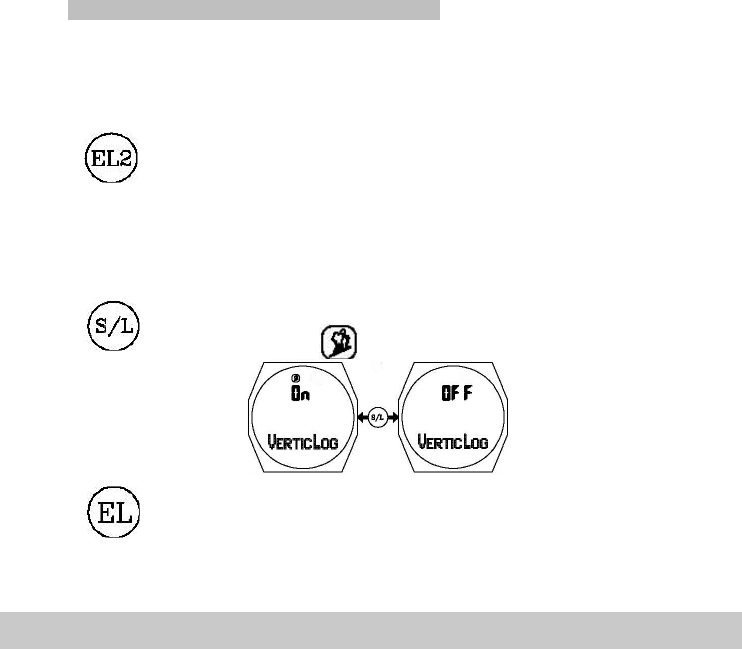
27
►STOPWATCH with VERTIC-LOG function
To switch on this function and continue working with it the stopwatch must be on
0:00:00 and ready for a new LOG.
Activate / deactivate the VERTIC-LOG function:
With this button you reach the settings menu of the PEER functions
(see 4.3.2) and the ON / Off switching of the VERTIC-LOG function.
You can also access the VERTIC-LOG function by pressing the S/R
key in the following sequence three times:
PAIR DEV. -->S/R--> FOOTPEER -->S/R--> SET ZONE -->S/R-->
VERTICLOG.
The element to be set (ON
–
OFF) will start to blink.
The VERTIC-LOG is activated / deactivated with this button.
If active the icon will appear.
Confirm setting and return to stopwatch.
If during setting for longer than one minute no button is pressed, the watch will
automatically leave the set mode. The settings made up to this point will be stored.
• Functions and operation

28
As soon as the stopwatch is started the VERTIC-LOG begins recording the
climb log.
One lap (LAP) is recorded per 100 m climbed. The first 100 m are LAP 1, the second
LAP 2 etc.
After a total of 1000 m of actual climbing (equals 10 LAPs), the time and the altitude
gain for these 1000 m is additionally stored (LAP +1000).
The same is done for the next 1000m etc. (LAP +2000, LAP +3000 etc.).
LAP 1–10
–
LAP +1000
LAP 11–20
–
LAP +2000
LAP 21–30
–
LAP +3000
etc.
Beginning the climb
To start the previously activated VERTIC-LOG function you must start the stopwatch
at the beginning of the climb you want to monitor!
Start the stopwatch and with that the VERTIC-LOG recording
Important: The recording of the climb will be interrupted when the stopwatch is
stopped. If you press the S/R button by mistake, do a “RESTART” with the S/L
button. The interrupted LAP x will be stored at its last status and a new LAP x+1 will
begin with the RESTART. If altitude was gained during this time it is lost to the
VERTIC-LOG recordings. To avoid unintentionally operating the STOP button (S/R)
we recommend activating the key lock.
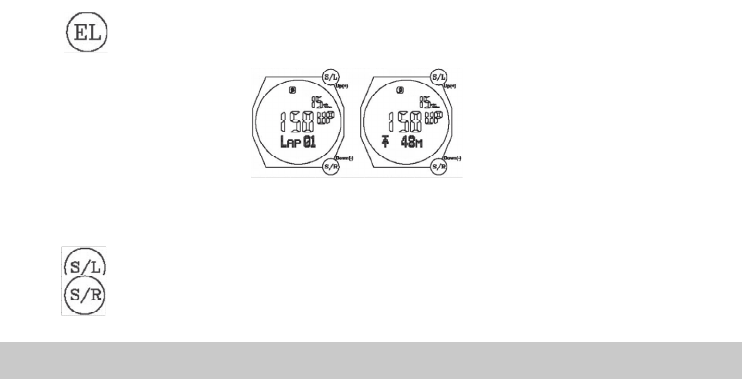
29
Operation during the climb
For each LAP during the climb,
that means while the stopwatch
is running, following data is
available:
– climbing speed in m/h as the case may be min/100 m
– in this LAP total meters climbed (UP). This means when you climb 50 m, then
descend 20 and climb 40 again that you are 70 m above the starting point
and UP 90m will be displayed.
– the LAP number alternates in a 2 second rhythm with the remaining meters until
100 m is achieved (in the example above that would be 30m)
Following display will then appear with the above data:
In this display the last segment (LAP) is always displayed.
With the S/L and S/R buttons you can retrieve previous recordings
which will be displayed for approx. 4 seconds.
• Functions and operation
Functions and operation •

30
When at least 10 LAPs have been completed, the “1000 Meter” summary will
appear if you press the EL button again.
Analogue to the individual LAPs here too the S/L and S/R buttons can be used to
scroll through other such summaries.
Return to the running stopwatch.
Functions and operation •
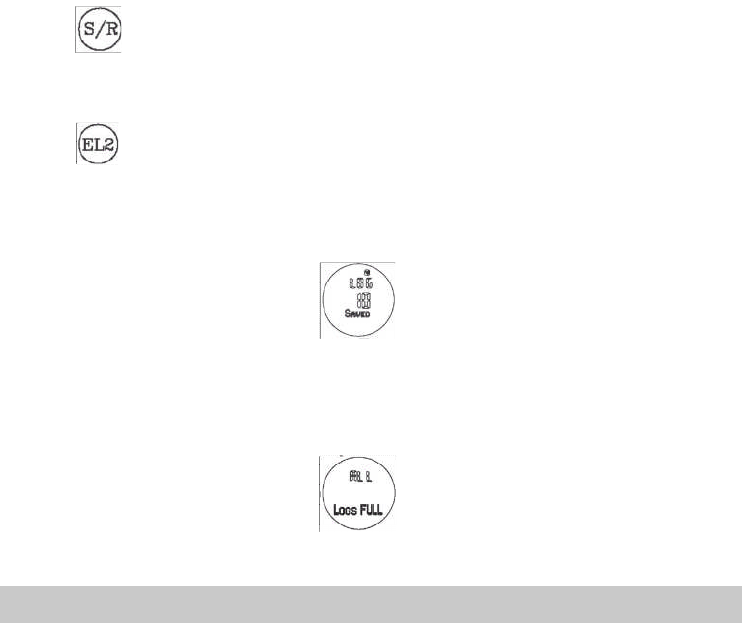
31
End of climb – Store data in LOG
Stops the stopwatch
To store when the stopwatch is stopped:
With this button the data can be stored in the LOG. The prompt “HOLD
TO SAVE” will appear. When the button is released the watch will return
to the current display. If you press the button for another 3 seconds the
data will be stored in the DATA LOG. The information “LOG xx SAVED”
(xx is the LOG number) will appear.
After successful LOG storing the stopwatch, in the SPORT mode, will return to the
initial value (0:00:00).
There are up to 10 LOGs available. If they have all been used “ALL LOGS FULL” will
appear at the next attempt to store.
In this case go to the function DATA LOG (see chapter 4.4), delete a LOG and then
return to SPORT, to store.
• Functions and operation

32
Attention:
In order to be able to retrieve additional data stored in the VERTIC-LOG, you must
store the LOG in the stopwatch function at the end of your climb. If you delete the
stopwatch times before storing, the VERTIC-LOG data will also be deleted!
Important:
The VERTIC-LOG function was developed for mountain climbers making ascensions.
When you have reached the highest point of your tour, stop the watch and store the
LOG. There is no need for descent data in the VERTIC-LOG! For longer interruptions
we recommend closing the LOG and when the tour is continued beginning with a new
LOG.
If you do not wish to store the LOG, you can delete the data (stopwatch and VERTIC-
LOG):
Delete (ERASE) the stopwatch times. The question “ERASE?” will
appear on the display. To confirm, press the button again for 3 seconds.
The data that has been deleted can not be retrieved! If you do not
want to delete the data, press and release the S/R button again and
move to LOG memory.
Functions and operation •
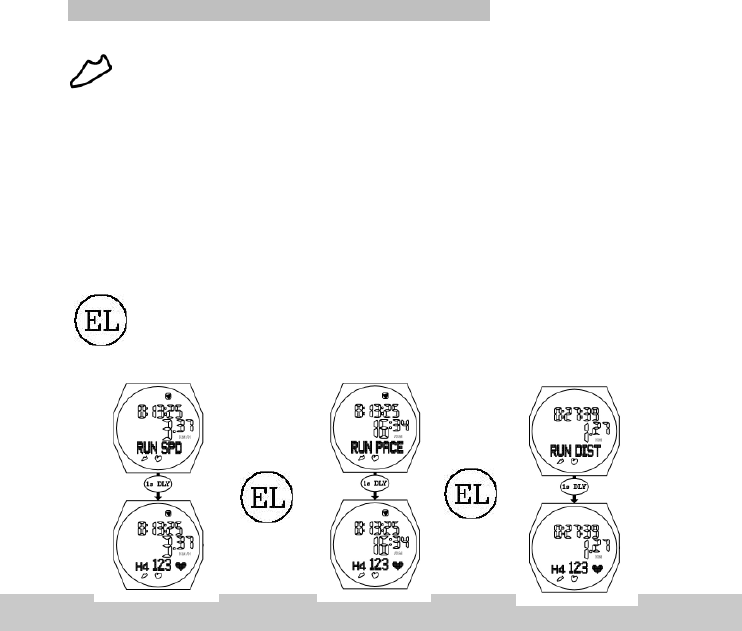
33
►STOPWATCH with RUN function (FOOT-PEER)
If a FOOT-PEER is available (icon active on display) the current data such
as
RUN SPD Speed (km/h)
RUN PACE Pace (min/km)
RUN DIST Distance (km)
are displayed.
--► From the stopwatch display (recommended with running stopwatch!)
you can call up the data above sequentially with each press of the key.

34
4.3.2 PEER Settings
To log the existing PEERS in the system (PAIRING) and to carry out the
calibrations/settings of the FOOT PEER and the HEART PEER, the stopwatch must
be on 0:00:00.
Entering the PEER calibration/setting mode:
--► You thus enter the setting menu for the PEER functions.
The menu ‘PAIR DEVICE’ is displayed first.
--► You thus enter the next setting menu after the following procedure:
PAIR DEV. -->S/R--> CALIB FOOTPEER -->S/R--> SET ZONE -->S/R-->
VERTICLOG -->S/R--> PAIR DEV. -->S/R --> etc.
VERTIC-LOG: see Chapter 4.3.1
--► You thus enter the setting mode of the function that is shown on the
display (functions: PAIR DEV. or CALIB FOOTPEER
or SET ZONE)
--► Exit setting mode and back to stopwatch.
If no key is pressed for around one minute, the system automatically exits
the setting mode and returns to the stopwatch.
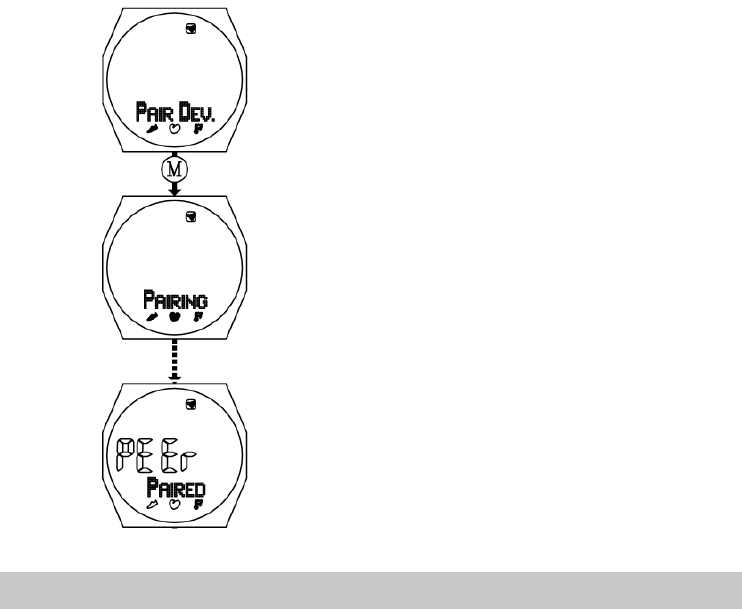
35
4.3.2.1 PAIRING (logging in of the PEERs)
The 3 icons flash for as long as the corresponding
peer is searched for. Duration of the process approx.
15 seconds.
If a peer is detected, the corresponding symbol stops
flashing.
If a peer has been detected after approx. 15 seconds,
this display appears briefly, then it reverts to the
display at the start PAIR DEV.